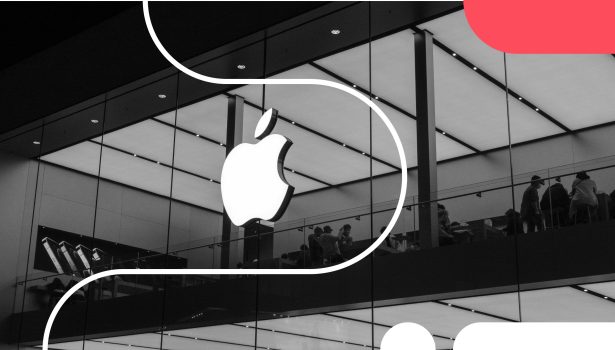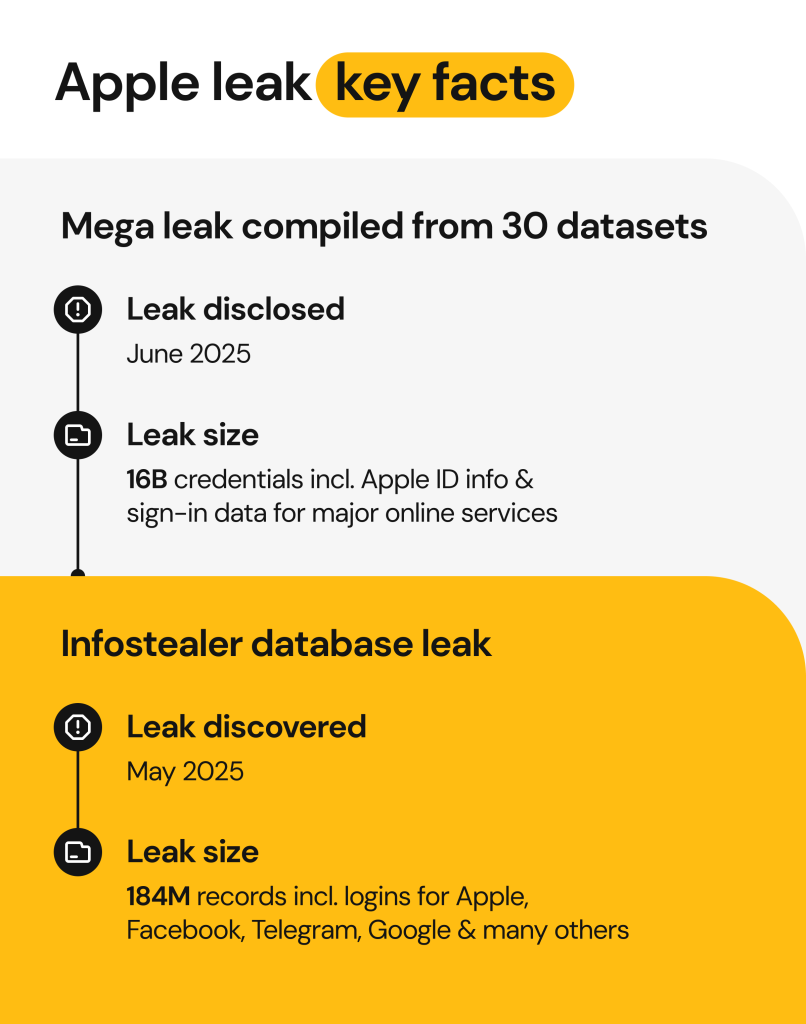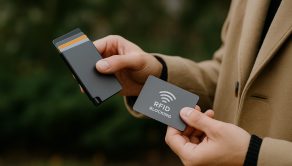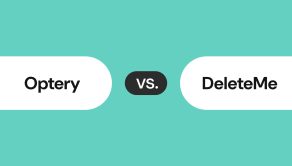Apple data leak: what you need to know to protect your information

Our world runs on digital platforms — and as more personal data moves online, the risk of exposure grows. A 2022 study estimates that 2.6 billion records were leaked in two years, showing how common data breaches have become.
In 2025, reports of an Apple data leak alarmed millions after Apple logins surfaced in massive password dumps — first in a 184 million–record leak, then as part of a much larger compilation containing billions of stolen credentials.
Despite claims of an Apple hack, investigators confirmed that Apple’s servers were not breached. The exposed Apple IDs came from infostealer malware that stole passwords from infected devices. Still, the risks are real: leaked credentials could let attackers access iCloud backups, Apple Pay, and other connected services.
This guide explains what really happened in the so-called Apple security breach, and what you can do to protect your data, devices, and identity from future breaches.

Was Apple hacked? What to know about the latest Apple security breach reports
The 184 million Apple login database discovery
The Apple data leak discovery is commonly attributed to cybersecurity researcher Jeremiah Fowler, after he found an unsecured database containing 184 million login records from companies like Apple. On June 1, 2025, Fowler reported his findings to Website Planet, an independent cybersecurity news website. The stored credentials were in plain text format enabling cybercriminals to easily weaponize the exposed data.
After reviewing the data, Fowler revealed multiple clues from the 47 gigabytes of raw, unencrypted data, concluding that the credentials didn’t come from an Apple data breach, but from infostealer malware. Much of the data he discovered included:
- Emails
- Usernames
- URLs leading to login pages
- Passwords
The data came from social media sites, financial institutions, and even healthcare portals.
The 16-billion mega password leak
Weeks later, cybersecurity researcher Bob Diachenko uncovered an even larger database of stolen credentials. His collaborative report was published on Cybernews, hinting that the massive “mega-leak” contained over 16 billion login records compiled from 30 datasets. In his findings, Diachenko confirmed the suspicion that the leak also exposed Netflix logins, Facebook credentials, PayPal data and sign-in info for just about every online service you can think of.
This iPhone password data leak became known as the largest password leak in history. It also marked its similarities to the Mother of All Breaches – another database containing billions of credentials compiled into an easily exploitable dataset.
These recent breaches appeared to contain mostly new login records. This distinction makes the dataset more dangerous, despite the data’s mix of quality and overlap with previous breaches. Further investigation revealed similarities in how data was stolen using infostealer malware.
The credentials were harvested from infected devices and from multiple sources rather than a compromised internal system. So, how did criminals steal users’ Apple IDs?
Why Apple wasn’t hacked (but Apple users were exposed)
Even though the company wasn’t hacked, Apple account holders need to know the difference between a data breach and a data leak. If an Apple security breach occurred, it means that threat actors carried out a direct attack on the company. However, an Apple password data leak can still occur if a data breach that includes Apple user credentials takes place.
Apple users can still find their sensitive information in unrelated leaks because of:
- Password reuse – Many people reuse their Apple ID login information for multiple websites. If one of these other services is compromised, then bad actors can use the same credentials to expose their Apple accounts.
- Infostealer malware – This type of malicious software extracts usernames and passwords from web browsers, messaging apps, or email clients while still collecting Apple IDs.
- Phishing scams – Threat actors try to mimic Apple’s branding in emails or SMS messages to trick users.
These factors offer the best explanation for why Apple IDs were compromised, even though Apple’s servers weren’t hacked. Some misleading headlines made it seem like criminals directly attacked Apple, but experts confirm that Apple’s systems are secure.
What data was exposed in Apple-related leaks?
The exposed records contained multiple types of sensitive, Apple-related information. Each data type could give threat actors advantages when trying to compromise other accounts or commit identity theft. A table below includes the Apple-related information that threat actors wanted to steal.
| Type of Data Exposed | Why It Matters |
|---|---|
| Emails & passwords | When threat actors steal this info, they can identify specific user data and compromise other connected accounts. |
| Plain-text passwords | Plain text passwords offer immediate account access to threat actors. If passwords aren’t changed regularly, they can be dangerous if reused for different services. |
| URLs & login paths | This data lets attackers see where each compromised credential belongs, making it much easier to target Apple, iCloud, or App Store login pages. |
| Autofill data | Your internet browsers store information you need regularly, so it can autofill it for you. Sometimes, autofill data includes sensitive details like addresses, payment information, and phone numbers. |
| Cookies & session tokens | Stealing this data allows threat actors to bypass two-factor authentication by restoring previous login sessions without a verification code. |
| Account metadata | Metadata may include information that assists attackers in legitimate scams or when they’re trying to mimic user behavior during login attempts. |
Apple IDs are valuable because they connect to almost every aspect of someone’s digital identity. Cybercriminals can use the connected services to acquire information about:
- iCloud backups can contain photos, sensitive documents, private messages, and authentication keys, which provide attackers with an idea of what information they should steal.
- Apple Pay, which stores payment data and linked credit cards, offers criminals the chance to commit financial fraud.
- Find My Device tracking data reveals a user’s real-time location, or allows attackers to lock or wipe devices remotely for ransom.
These are some of the main reasons why Apple ID data is particularly valuable. But what happens if a cybercriminal compromises your Apple ID?
What happens if your Apple ID (or iCloud) is compromised?
If a threat actor gains access to your Apple ID, the impact extends far beyond a single account. An Apple ID connects your financial data, iCloud backups, and device management within one digital ecosystem — meaning one stolen password can expose multiple points of vulnerability.
With unhindered access to your Apple account, cybercriminals could:
- Schedule unauthorized purchases using Apple Pay – Criminals could schedule multiple fraudulent transactions, add, or expose other payment accounts, similar to cases explored in content asking “is Apple Pay safe to use online”.
- Commit identity theft – Criminals can use your iCloud account to obtain more personal information about you. With more sensitive information, they can launch impersonation scams or expose more information in new data leaks.
- Launch phishing and social engineering scams – When an attacker controls your Apple ID, they can impersonate you or try to scam your synced contacts.
- Access stored authentication tokens – Sometimes, attackers may steal saved authentication sessions from an infected device to re-enter your account.
- Infiltrate other connected devices – Your Apple ID syncs across multiple devices. A compromised device is dangerous in any capacity, but attackers could use your compromised Apple ID to access your connected iPhones, Macs, and iPads.
Is Apple safe? Understanding Apple’s security measures
Yes, Apple is safe to use. The company uses multiple layers of protection to keep user accounts secure. Although no system can stop all security breaches, Apple has documentation that explains several key defenses:
- Password monitoring & leak alerts – Apple’s iOS and macOS can detect and notify users when their saved passwords appear in known data leaks.
- Encrypted credential storage – When users store their passwords using Apple’s “Passwords” system, it’s encrypted. Apple never stores raw password information.
- Privacy and data minimization design – Apple actively limits how much data bad actors can access, using industry-standard privacy techniques and technologies across its device ecosystem.
- Lockdown Mode – This feature is active on most newer iOS versions and restricts features to defend against sophisticated online attacks.
Also, many Apple Store apps have built-in features that prevent any service from making changes without permission.
How to check if your Apple account was affected
Apple’s user protections make devices safer than most alternatives, but they aren’t immune to all cyberattacks. If you’re concerned about your exposure risk from a recent Apple data leak, here are several ways to check your status:
- Check your account using trusted breach tools like HaveIBeenPwned to see if your credentials were part of a recent Apple hack. Onerep now offers the same functionality as part of every subscription plan — automatically checking for compromised email addresses and other details, and alerting you if your data appears in a breach.
- Check your linked Apple services and devices for unusual activity. Look for unexpected sign-in notifications, device logins, or password reset emails, as each may be someone attempting to access your account.
- Confirm your Apple account devices to prevent unauthorized access. Go to your account settings, review each device linked to your Apple ID, and remove ones you don’t recognize.
What to do if your Apple password was exposed
What happens if you discover your Apple password was compromised by a recent Apple password leak? It’s best to act quickly and according to a plan.
- Scan every Apple device you have for malware, especially if the device is infected with malware. Even if you change your password, hackers can steal your info again.
- Change your Apple ID password after cleaning any infected devices. When creating a new password, use at least 16 characters and never reuse old passwords. Use Apple’s compromised account steps to fix compromised Apple IDs.
- Enable two-factor authentication or use hardware security keys. Use Apple’s two-factor authentication services and enable FIDO-certified security keys for devices using iOS 16.3 or macOS 13.2 to protect against phishing-related logins. Don’t use SMS codes.
- Harden your iCloud account by turning on Advanced Data Protection, which extends end-to-end encryption to your device backups, photos, notes, and more.
- Enable stolen device protection features for devices using the newer iOS 17.3+ operating system. A source confirms that these features add biometric checks and delays to protect your account when someone attempts to change sensitive information after stealing your device.
When fixing a compromised Apple account, it’s important to remove the infection, lock down unauthorized sign-ins, and plug up entry points for cyberattacks so threat actors have less to work with.
Best practices to prevent future Apple Data leaks
An Apple breach can happen at any time; that’s why a proactive defense is the best way to prevent future leaks. Users can use these other ways to combat an Apple data leak:
- Switch to passkeys – Passkeys can replace traditional passwords with cryptographic keys, which stop phishing and credential-stuffing attacks from happening. Companies like Google, Microsoft, and Apple are already using them.
- Use password managers – Apple account holders should use password managers to create unique credentials for all accounts. Reusing passwords compromises your accounts, a pattern seen in the Facebook data leak.
- Always use trusted app stores – Everyone should use verified sources for all online activities. Never download apps from unverified stores, as some malware infections can originate from fake downloads. This was a critical factor in the PayPal data breach, showing that bad actors can hide malicious code in app downloads.
- Manage your digital presence – Your digital footprint provides threat actors with context about your identity, habits, and online behavior, making it easier to target you in personalized scams. Shrink your digital footprint by limiting the information scammers have to enrich their efforts against you.
How Onerep can help protect your privacy
Managing your online privacy doesn’t just mean securing your passwords. Users need to limit where their information lives online. Data brokers continuously collect and resell consumer details, enabling bad actors to connect real identities with leaked credentials.
With a free Onerep scan, you can instantly see which data broker sites expose your information and automatically remove it from those sources — reducing your overall risk of identity theft and fraud.
👉 Start your protection with a free privacy scan
FAQs
Has Apple had a data leak recently?
Yes, security researchers found Apple logins in the 184 million record leak and the 16 billion password “mega-leak.”
Why is my iPhone saying I have a data leak?
Many Apple devices use built-in password monitoring features that alert users when saved credentials appear in known breaches.
Are Apple data leak warnings real?
Yes, those alerts are generated by Apple’s security features. They present a real threat, and if you receive one, update your compromised passwords immediately.
What should I do if my Apple password was leaked?
Start by scanning your device for malware, then change your Apple ID password, enable 2FA, and verify all devices signed into your account.
Can someone hack my iPhone with my Apple ID?
It’s rare, but possible for someone to hack your iPhone with your Apple ID, especially if your credentials are compromised.
Is Apple safer than Android when it comes to privacy?
Apple generally offers stronger privacy features and faster security updates. Following best practices will help keep your data more secure.





Mikalai is a Chief Technical Officer at Onerep. With a degree in Computer Science, he headed the developer team that automated the previously manual process of removing personal information from data brokers, making Onerep the industry’s first fully automated tool to bulk-remove unauthorized profiles from the internet.